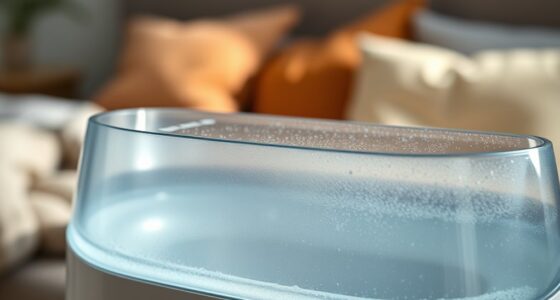To stop window condensation for good, you need to control both indoor humidity and window temperature. Keep humidity levels below 50% with proper ventilation and exhaust fans, especially during cooking and showering. Improve window insulation with double-pane glass, weatherstripping, or thermal curtains to keep glass warmer than the dew point. Combining these tactics creates a moisture-proof barrier, so your windows stay clear. Keep exploring these dew point hacks to master dry, fog-free windows long-term.
Key Takeaways
- Increase indoor ventilation with exhaust fans or ERVs to lower indoor humidity and reduce condensation risk.
- Insulate windows with double or triple-pane glass and weatherstripping to keep surface temperatures above dew point.
- Maintain indoor humidity levels below 50% using dehumidifiers or proper air circulation.
- Use thermal curtains or window films to improve heat retention and prevent glass surfaces from cooling below dew point.
- Manage indoor moisture sources like cooking and showering to prevent excess humidity buildup.

If you’re tired of dealing with foggy, condensation-covered windows, the good news is that you can eliminate this problem once and for all. The key lies in understanding and controlling the dew point—the temperature at which moisture in the air turns into water droplets on your windows. To do this effectively, you need to implement proper ventilation strategies and improve window insulation. These approaches work together to reduce indoor humidity and keep your windows dry, even during cold weather.
Ventilation strategies are essential because they help manage indoor humidity levels. When moisture builds up inside your home—whether from cooking, showering, or even breathing—it increases the likelihood of condensation on your windows. By increasing air circulation, you can lower indoor humidity and prevent excess moisture from settling on cold glass surfaces. Simple measures like using exhaust fans in your kitchen and bathroom, opening windows periodically, or installing an energy recovery ventilator (ERV) can make a significant difference. ERVs especially help exchange stale indoor air with fresh outdoor air while maintaining temperature and humidity levels, keeping your home well-ventilated without sacrificing energy efficiency.
Increasing air circulation reduces indoor humidity and prevents window condensation.
Alongside proper ventilation, window insulation plays a critical role in controlling condensation. When your windows are poorly insulated, they rapidly lose heat, causing the glass surface temperature to drop below the dew point. As a result, moisture in the air condenses on the cold surface. Upgrading to double or triple-pane windows with low-emissivity (low-E) coatings can drastically improve insulation. These types of windows reduce heat transfer, keeping the glass warmer and preventing it from reaching the dew point. Additionally, applying weatherstripping and sealing gaps around your window frames minimizes drafts, ensuring that indoor heat stays inside and your windows remain warmer.
You can also use thermal curtains or window film as supplemental insulation. These add an extra barrier that helps retain heat near your windows, especially during cold winter nights. When combined with good ventilation practices, these insulation measures create a balanced environment—reducing indoor humidity while maintaining the glass temperature above the dew point.
Frequently Asked Questions
Can Window Condensation Damage My Home’s Structure?
Yes, window condensation can damage your home’s structure over time. When humidity control isn’t managed, moisture seeps into the walls and framing, leading to wood rot and mold. Improving insulation helps keep indoor temperatures stable, reducing dew point issues. By controlling humidity and enhancing insulation, you protect your home’s structure from moisture-related damage and keep your windows clear and dry.
Is Condensation More Common in Certain Climates?
Condensation is more common in humid climates and cold regions. In humid areas, high moisture levels increase the likelihood of window condensation, especially when indoor air is warm and moist. Cold regions experience condensation because warm indoor air hits cold window surfaces, causing moisture to form. To prevent this, you should control indoor humidity and improve insulation, helping to keep window surfaces warmer and reduce condensation buildup.
How Quickly Can I See Results After Applying Hacks?
You can see results within a few days if you implement humidity control and ventilation tips effectively. Improving airflow and reducing indoor humidity quickly lowers the dew point, preventing condensation. Keep windows open during dry weather, use exhaust fans, and consider dehumidifiers. These hacks work fast because they directly address the moisture levels in your home, making your efforts noticeable in just a short time.
Are There Eco-Friendly Solutions to Prevent Condensation?
Yes, you can prevent condensation with eco-friendly solutions like natural dehumidifiers and eco-friendly insulation. Using materials such as hemp or wool insulation helps regulate humidity and keeps your windows dry. Natural dehumidifiers like charcoal or silica gel absorb excess moisture without chemicals. These eco-conscious options are effective, safe for the environment, and improve indoor air quality, helping you stop window condensation sustainably and efficiently.
Does Condensation Affect Energy Efficiency Long-Term?
Did you know that poorly managed condensation can increase your energy bills by up to 25%? Yes, it affects long-term energy efficiency. When humidity control isn’t maintained, your heating and cooling systems work harder to compensate. Upgrading insulation and improving ventilation prevent moisture buildup, keeping your home more energy-efficient. So, addressing condensation early not only saves money but also preserves your home’s insulation and overall energy performance.
Conclusion
By applying these dew point hacks, you can finally say goodbye to frustrating window condensation. Did you know that up to 90% of indoor moisture issues stem from poor ventilation and temperature differences? Keep your windows dry and clear by controlling humidity and airflow. With just a few simple steps, you’ll create a more comfortable, mold-free space. Start today, and enjoy clear views without the constant fog—your home will thank you!









